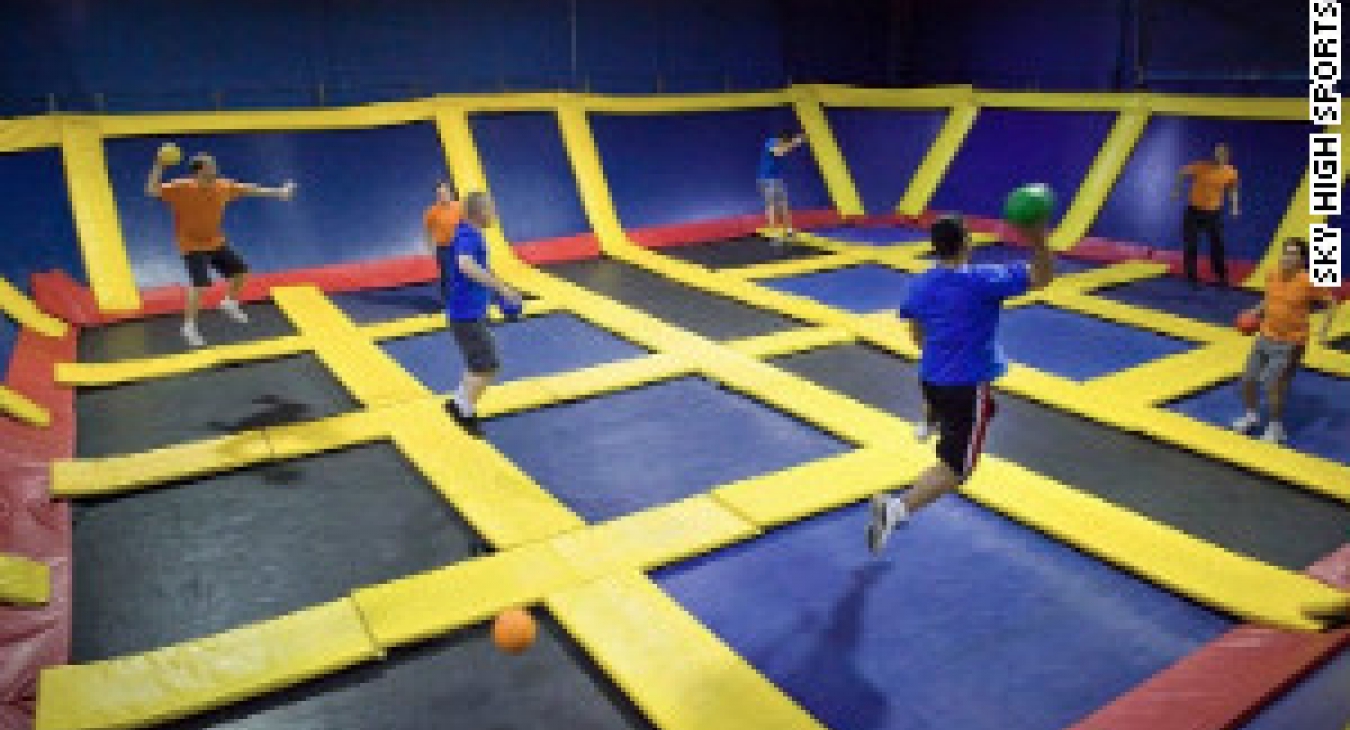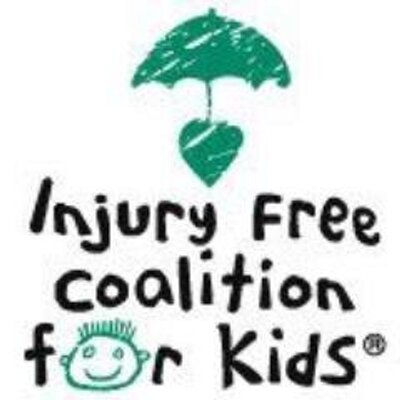Trampoline Park Safety
One of the greatest gifts we have been given as Americans is our freedom to pursue happiness. Happiness comes in many forms and one of the “newest” forms of finding happiness and enjoying ourselves is using a trampoline at a commercial facility – the Trampoline Court/Park.
The Trampoline Park is an indoor recreational facility that allows both adults and children to participate in a multitude of activities such as: wall to wall trampolines, dodge ball, foam pits, fitness events, camps, and gymnastic/cheer practices for a fee. Many facilities offer “free play” times, party rentals, fundraising opportunities, as well as times for different types of teams.
The trampoline park is made of many components. A key safety feature is that the components are designed and built by engineers to be used in a commercial setting. Many times the parts of a trampoline court include: frame structures, springs, beds, mats, safety netting and pads.
Another safety element is that staff at these facilities have completed safety and crisis training and are able to respond to an emergency quickly. The trampoline facility should be able to supply participants examples of that training.
Additionally, some facilities sell, rent, or offer for free form helmets, ankle braces, and socks with grips to reduce head collisions, cuts, and bruises. Weight limits and rules should be clearly posted and enforced.
As with any type of high risk recreational activities (for example: rope courses, zips lines, surf pools, and rock climbing), physical demands may be great and an in-depth understanding of the activity (what are correct actions and what could go wrong) should occur.
Trampoline parks have opened in almost every state and examples of injuries and lawsuits are starting to surface. The article that follows is an outstanding explanation of the current state of affairs in the trampoline industry.
Lawsuits ignite debate over trampoline park safety
By Emanuella Grinberg, CNN, published July 27, 2012
(CNN) -- Christina Flygare's son had his summer all planned out: landscaping job, swimming and hanging out with friends, then band camp before his senior year of high school.
Instead, the 17-year-old Washington teen spends his days relearning to walk, shower and eat without his mother's help. He hopes to regain his fine motor skills so he can hold a pen and write in time for school in September.
His mother says she's just happy he's alive after he suffered spinal cord injuries in April at a trampoline facility in Bellevue, Washington. Flygare believes the owners and operators of Sky High Sports Seattle are responsible for her son's injuries and has filed a lawsuit seeking undisclosed damages for his care.
"It's devastating to see your child go from being a vibrant athlete -- laughing, playing, running and jumping -- to sitting on a sofa feeling down and gloomy because he can't do the things he should be doing," said Flygare, a single mother of seven employed as an office assistant.
Flygare and her son are one of 18 families in the Seattle area with negligence claims against Sky High Sports' Bellevue location. Of the 10 filed since 2010, Sky High claims four were settled by its insurance company, despite its desire to go to trial. Six more are pending, and the firm Osborn Machler plans to file eight more.
The families, who are all represented by Osborn Machler, allege that Sky High's "trampoline fun centers" are inherently dangerous in the way they are designed, maintained and supervised. But the lawsuits go beyond Sky High and Washington, sparking safety concerns over an industry that only seems to be growing. Even Orange County "Housewife" Alexis Bellino and her husband are apparently cashing in on the craze by opening a new facility in California billed as the largest in the United States.
Flygare and other parents claim the centers are accidents waiting to happen. Business owners, however, say trampoline use leads to fewer injuries than most sports and that it's up to parents to assess the risk.
Eric Beck, owner of two trampoline centers in suburban Chicago, advertises his injury rate on Xtreme Trampoline's website to help people make informed decisions, he said. Beck said his facility reports lower injuries than many common sports: about 2 per 1,000 trampoline jumpers. He pointed CNN to a 2002 study in the American Academy of Pediatrics Journal analyzing injuries in organized youth sports. The study shows injury rates equivalent to 15 per 1,000 players in football and 21 per 1,000 in soccer.
Like many owners and operators of trampoline parks, Beck opened his first facility about year and a half ago, after he visited another with his 6-year-old son. It was only a matter of time before his facility was slapped with a lawsuit, he said, because "everyone who owns a trampoline park in the United States will eventually get sued.
"Because this is a very fast-growing industry, the only ones who haven't been sued are the ones who haven't been around for very long. It's the way our legal system works."
Beck's trampoline center in Carol Stream was sued earlier this month along with Sky High Sports Niles, a subsidiary of Sky High Sports, by two different families. Both families accuse the centers of improper supervision and failing to enforce rules prohibiting more than one jumper on a trampoline at a time, attorney Mike Holden said.
"Double-jumping" can cause injuries as one person lands while the other attempts to jump. Both lawsuits allege that double-jumping contributed to leg fractures in 5-year-old girl and a 9-year-old boy in 2011.
"Fortunately, we're talking about broken bones and not paralysis," said Holden, whose firm, Romanucci & Blandin, is representing both families. "But it can easily degrade into that if these facilities continue to operate in such a way."
From training devices to 'backyard trampolines'
Trampolines were initially designed as training devices for gymnasts and acrobats and later, military pilots, whose bodies go through different orientations while in flight, said Dr. Gary Smith, president of the Child Injury Prevention Alliance and spokesman for the American Academy of Pediatrics.
They evolved into consumer products when manufacturers found ways to break them down into smaller parts at affordable prices, leading to the rapid expansion of backyard trampolines, he said.
Trampolines are a great source of aerobic exercise and help develop balance and coordination if used properly, he said.
"They're not inherently dangerous. It's about how you use them," said Smith.
"The best way to learn is to go down to local gym and do it under the training of gymnastic instructors and let them progress you through maneuvers," he said. "We really want to encourage people of all ages to be physically active. We just want them to do it in a smart way so they don't end up decreasing physical activity due to injuries."
Several public health agencies have issued advisories on "backyard trampolines" in homes but have yet to clarify a stance on trampoline facilities, which are unregulated by state or federal agencies -- often because they are neither mechanical nor electrical.
There were 92,159 hospital emergency room-treated injuries associated with trampolines in 2010, according to the U.S. Consumer Product Safety Commission, the latest year for which statistics are available. That figure doesn't specify whether those injuries in homes or at trampoline centers.
In a 2006 position statement, the American Academy of Pediatrics recommended "that trampolines should never be used in the home environment, in routine physical education classes or in outdoor playgrounds." They reaffirmed that position in summer safety tips this year, which advised that parents "should never purchase a home trampoline or allow children to use home trampolines." There was no explicit reference to trampoline parks.
The American Association of Orthopedic Surgeons also weighed in on trampoline safety advice in March after Yankees baseball player Joba Chamberlain suffered a career-threatening ankle injury while jumping on a trampoline with his 5-year-old son at a children's play facility in Tampa.
"Although trampolines can be fun for both kids and adults, they pose a high risk for injuries, especially when two or more people jump at one time," said AAOS spokesman and orthopedic surgeon John Purvis. "Orthopedic surgeons recommended that trampolines not be used in home environments or in outdoor playgrounds because of the high risk of injuries this activity."
Most injuries result from colliding with others, landing improperly or falling off or onto the springs or frames, the Consumer Product Safety Commission notes.
Yet, trampolines continue to be sold in sporting good stores because the ones on the market are as safe as ever, said Mike May, spokesman for Sporting Goods Manufacturers Association.
"There is an element of risk whenever anybody participates in a sport, athletic, or recreational activity. In the area of trampolines, it's important that the end user/consumer follow some procedures while using the equipment," he said in an e-mail.
"Trampoline use should always be supervised, especially if young children are using the apparatus. It's a good idea for only one person to use the trampoline at a time. It's important that the trampoline be well maintained and that it is positioned on a flat surface or solid ground. All the 'legs' of the trampoline must be touching the ground. It's also a good idea for first-time users of a trampoline to be given some basic instruction prior to using it," he said.
"After trampolines are purchased, it's the responsibility of the consumer to properly maintain the equipment. When trampolines are misused, accidents can happen. When used with care and supervision, using a trampoline can be fun and safe."
'Cushier than a corner office in a marshmallow factory'
Sky High founder and co-owner Jerry Raymond says the equipment in all 16 facilities nationwide is engineered to minimize those risks and ensure the safety of trampoline floors, walls and foam pits.
Still, just like other sports, trampoline use carries risks, which is why each visitor signs a waiver of liability before stepping on the floor, Raymond said. The number of injuries compared with the total number of visitors makes the lawsuits seem blown out of proportion, he said.
"We're proud to have hosted millions of satisfied patrons at our 16 locations across America. Since opening in August of 2009, our Bellevue location alone has hosted more than 650,000 happy 'jumpers,' " Raymond told CNN. "Sky High Sports maintains the safest possible environment, utilizing best practices including daily and weekly inspections and maintenance of equipment and courts and by delivering a comprehensive training course in safety and rules enforcement to every employee."
But Flygare maintains that she witnessed a "free for all" of children and adults bouncing all over when she and her children visited Sky High for her daughter's 16th birthday on April 28. Less than 15 minutes into the visit, her son hit his head and neck on the frame of the trampoline as he was attempting a flip into a foam pit, she said.
She still gets choked up as she recalls the sound of his head thudding against the frame and hearing his neck snap. Looking at his contorted body lying in the foam pit, she thought he was dead.
"You never forget it," she said in a phone interview. "It's the worst nightmare a parent can go through."
The incident left him partially paralyzed, the lawsuit alleges. He missed the last two months of school while spending almost three weeks in the hospital, followed by doctor's appointments and rounds of occupational and physical therapy for damage to his central nervous system resulting from spinal cord injuries.
Her lawsuit, filed June 6 in King County Superior Court, accuses Sky High of failing to properly cover and pad the metal bars and pipes near the foam pit where her son was jumping. It also alleges that Sky High failed to provide adequate supervision and safeguards.
"It's not a question of if someone's going to get hurt, it's when someone is going to get hurt," said Flygare's lawyer, Sim Osborn.
Allowing children and adults on the same floor and encouraging them to do flips and jumps creates a risk of collisions or worse, he said.
When it comes to equipment design and maintenance, Sky High advertises the padding on the trampolines as "cushier than a corner office in a marshmallow factory," Osborn said. But, Flygare's son and at least two other clients claim their injuries resulted from colliding with the frame.
But Sky High's co-owner says his trampolines are specially manufactured for extra stability well beyond your typical backyard trampoline. Its frames are spring-loaded with extra padding to create give and reduce impact.
As far as equipment maintenance goes, employees conduct minimum weekly inspections for any issues with structural integrity, a company spokeswomen added. Court monitors conduct daily inspections of the networks of trampolines, checking for tears, rips or misplaced padding.
Sky High takes floor supervision very seriously and requires potential employees to go through a rigorous screening and training process, spokeswoman Trayce Zimmerman said in an e-mail. Applicants are screened for characteristics including the ability to firmly enforce rules -- among them, no double bouncing; no out of control play on courts; and additional behaviors and actions that might lead to unsafe play.
Potential employees go through at least three days of training and orientation, which includes classroom-style education, case studies, video presentations, group discussion and role play, she said. Trainees learn how to anticipate rules infractions, enforce rules to a variety of patrons and how to properly correct and educate patrons so that they may continue to play safely. Finally, potential hires must score 100% on a written test.
"Proactive rule enforcement is a best practice to prevent injury," she said.
In light of the growing popularity of trampoline parks, the American Academy of Pediatrics said it plans to revise its trampoline safety advisory to include a position on trampoline parks. In the meantime, Christina Flygare's goal is to make the public aware of the potential hazards of accepting the invitation to "bounce off the walls."
"I want the word out there so every parent knows the risk," she said. "No parent should have to go through what we're going through."
Top photo: Visitors to Sky High Sports can also use the trampoline courts to play dodgeball.
http://www.cnn.com/2012/07/27/living/trampoline-park-accidents-injuries/index.html
The ASTM International just this year has developed a standard for Trampoline Facilities (F2970-13). It should be reviewed and followed by anyone interested in owning and operating a Trampoline Park. Below is some information on the standard.
The Standard Practice for Design, Manufacture, Installation, Operation, Maintenance, Inspection and Major Modification of Trampoline Courts - Designation: F2970 − 13 states:
The purpose of this practice is to delineate requirements regarding the design, manufacture, installation, operation, maintenance, inspection and major modification of commercial or institutional trampoline courts with the primary purpose of amusement, entertainment or recreation. 1.2 This standard applies to institutional trampoline courts that are located in and around amusement, entertainment or recreational facilities. Such facilities include but are not limited to trampoline parks, amusement parks, theme parks, water parks, family entertainment centers, fitness centers, gyms, gymnastics facilities, sports facilities, skate parks, camps, shopping centers, temporary special events, carnivals and municipal parks. 1.3 This practice establishes guidelines that will provide a level of conformity for the purpose of reducing potential hazards to patrons, court attendants, and spectators.
 This standard also requires Field Testing of Impact Attenuation—In Service Materials. PlaySafe, LLC owns an “A” Missile and can conduct the testing.
This standard also requires Field Testing of Impact Attenuation—In Service Materials. PlaySafe, LLC owns an “A” Missile and can conduct the testing.
This standard is available for purchase at:
http://www.astm.org/Standards/F2970.htm
No one wants to go out for a day of fun and become injured! Only with the hard work of the ASTM International, responsible operators of trampoline courts, and informed participants we can avoid some of the injuries and lawsuits that have occurred and have a fun, active recreational experience.
Additional information is also available from:
U.S. Consumer Product Safety Commission
http://www.cpsc.gov/PageFiles/137868/085.pdf
American Academy of Orthopedic Surgeons Position Statement 1135









